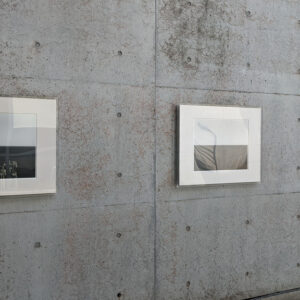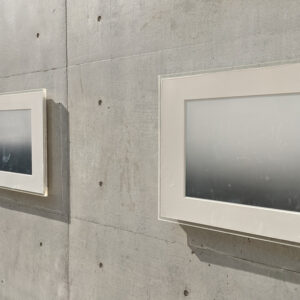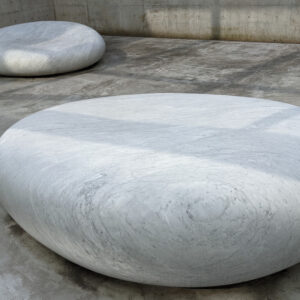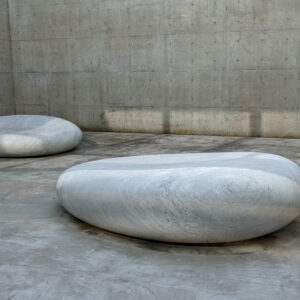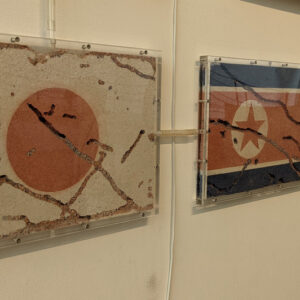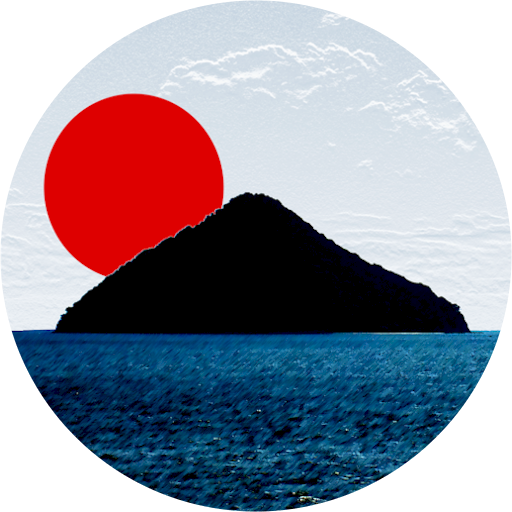If you’ve heard of Naoshima, you have most likely heard of the Benesse House Museum.
Since its opening in 1992, it has been the centerpiece of the ensemble of museums, galleries, and artworks collectively known as Benesse Art Site Naoshima.
In 1988, shortly after Soichiro Fukutake took over his father’s project to develop the southern part of Naoshima, the billionaire wanted a “place to put his art collection” near the Naoshima International Camping Ground (that has since become the Benesse House Park & Beach). He decided to have a museum built.
For this project, he contacted Japanese architect Tadao Ando and this was the beginning of their long collaboration that has reshaped this part of the island as well as art tourism in Japan.
The idea behind the design of the building was for it to be “an ideal place for works of art that convey a message to be displayed in a natural setting.” Indeed, like a lot of Ando’s works, while the structure of the Benesse House Museum revolves around very basic geometrical shapes – rectangles, circles, and triangles – it has an organic dimension and doesn’t feel separated from its natural setting. This is due to several factors. First, the different shapes are assembled in a labyrinthine layout. Also, as often with Ando, the building was designed with the surrounding nature in mind. The final shape of the building is intrinsically linked to the topography of the place. And the large openings in different areas of the museum allow for optimal use of daylight as well as allow Naoshima’s landscape to be seen in several parts of the museum, reminding the visitors that nature and art are inseparable. An idea that is recurrent all over the Art Setouchi islands.
The Benesse House Museum also has a particularity that was unique at the time of its inception. It is both a museum and a hotel.
The reason is actually quite prosaic and comes from the infamous Japanese administrative red tape. Japanese laws and regulations didn’t allow for a museum to be built in that location. However, building permits for a hotel – as long as it had a sloped roof – could be delivered. And this is how this project for a museum ended up becoming a museum and a hotel at the same time. There is also a sloped roof somewhere on top of the building.
So, when you come to Naoshima, not only you can visit the Benesse House Museum, but you can also sleep in one of its rooms. At the start, there were only 10 rooms, but several annexes were added over the years. Namely, the Oval in 1995, the Benesse House Park and Beach in 2006. Nowadays, several dozen rooms can welcome guests.
Guests at the Benesse House have a few special privileges. First, artworks from famous artists can be found in some rooms. Yes, you can sleep with the painting of a famous contemporary artist above your head. Also, guests have access to the museum after closing time. You basically have the museum to yourself (and a few other guests) and can experience it in a very different way, including under a unique light. Finally, you can also enjoy the outdoor bath that is also an art installation by Cai Guo-Qiang and that is called Cultural Melting Bath: Project for Naoshima.
But only some lucky few can experience those, for the rest of us, here is what you can expect.
Inside the Benesse House Museum
One criticism that museographers have made about the Benesse House Museum is that the art there lacks unity or a theme. It’s just a bunch of contemporary artworks grouped together more or less randomly in the same building. It is somewhat true, and the reason is simple. The museum literally started with Soichiro Fukutake wanting a building to store his personal art collection.
Yet, most visitors don’t really care about that.
What can you find inside?
Instead of long descriptions, why don’t I show you?
At the entrance, you’ll be welcomed by Alberto Giacometti’s Diego sur Stele I (picture coming sooner or later) and César’s Hommage à Monaco MC12:

Next, you’ll most likely enter the rotunda that only has a few artworks in it, especially Bruce Nauman’s 100 Live and Die (1984), but it’s one of the few artworks that can’t be photographed for some reason. The rotunda itself is an amazing room, though:
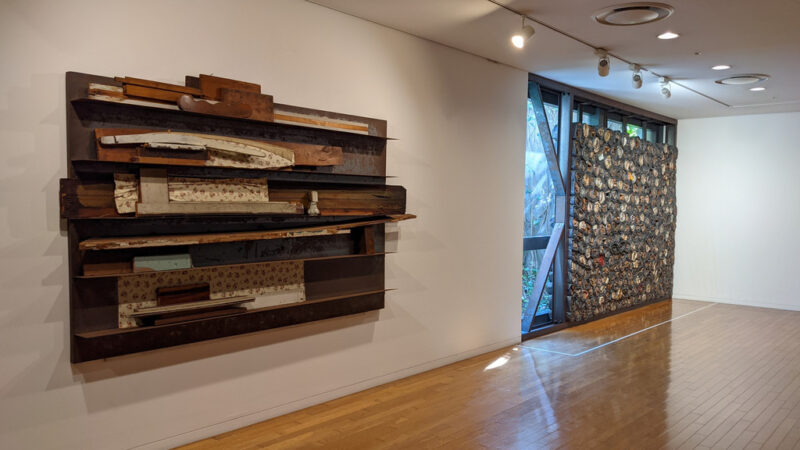
One of the largest rooms of the Benesse House Museum (and definitely the longest). You can find about a dozen artworks there, including:
Yellow and Black Boats by Jennifer Bartlett (1985)
An artwork that is in three parts. You can see two of them here: a painting on the wall, and an installation on the floor.
For the third part, you’ll need to turn around, walk outside to the terrace and look to the distance :
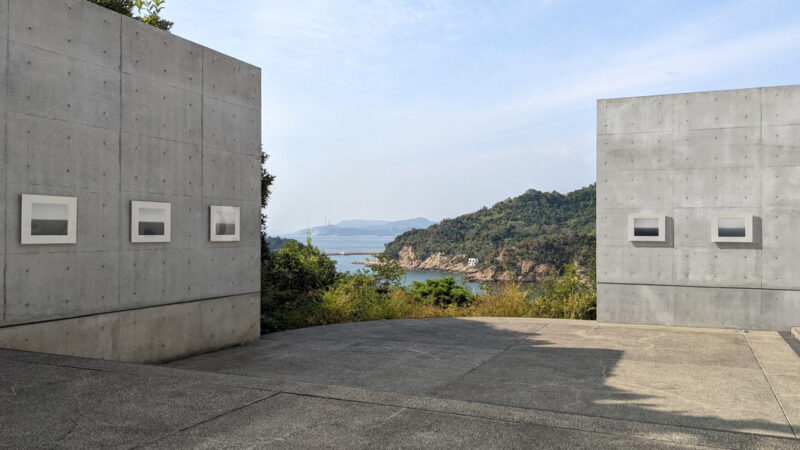
Look, on the beach, do you see the small yellow and black boats?
While we’re on the terrace, let’s take a look at some shots from the Time Exposed series by Hiroshi Sugimoto.
Time Exposed is a series of black and white pictures that Sugimoto took between 1980 and 1997. It’s always the same picture, but it’s never the same picture. They are pictures of the horizon above the sea in different parts of the world, at different times, under different weather, with the horizon exactly in the center of the picture. Also, as the pictures are outside, in the sun, the older ones are slowly deteriorating. It’s part of the project and it explains the title too.
A certain number of them are exhibited on the terrace, a few more can be found outside in different locations around the museum. Can you spot the one in the picture above? The one on the beach with the two boats?
The Secret of the Sky by Kan Yasuda (1996)
Two big polished stones that look like cushions and that you can actually use as cushions to observe the sky if you wish so.
Another striking artwork in this part of the Benesse House Museum is The World Flag Ant Farm 1990 by Yukinori Yanagi. And it’s exactly what the title says it is:
All the flags of the world (in 1990), are made of sand and dirt. They’re all connected by small tunnels, and it’s also a large ant farm. Indeed, an ant colony used to live there when the artwork was installed. With time, they dug galleries through the flags, some of them have collapsed.
A few more artworks in the other parts of the museum:
Inland Sea Driftwood Circle (on the floor) and River Avon Mud Circles by the Inland Sea (on the wall) by Richard Long (1997)
Left (outside): Full Moon Stone Circle by Richard Long (1997)
Right (inside): Highway Painting No.9 by Elmgreen & Dragset (2019)
Great Criticism: Disney (2000) by Wang Guangyi
Shipyard Works: Bow with Hole (1990) by Shinro Ohtake
This last picture is on the top floor where you can also find a small restaurant and book & souvenir shop.
Outside the Benesse House Museum
In addition, many artworks can also be found around the museum. Here are a few of them:
If you want to see some of them more closely, may I invite you to watch this video?
Practical Information
Here are the things you need to know before visiting the Benesse House Museum (note that they’re subject to change at any time)
The museum is open every day from 10 am to 6 pm.
Admission is 1,050 yen. It’s free of charge for teens and children under 15 years old as well as for hotel guests. Please refer yourself to the official site for hotel information.
Please follow the rules of the museum while visiting it. They’re written on your ticket. Nothing special: do not touch the art, do not eat or drink in the museum, do not be obnoxious and be a decent human being, etc.
If you have any questions or comments, do not hesitate to contact me.
The text and pictures are my own. If you want to reuse them, please contact me first. Thank you for your understanding.
I write this website in my free time. If you want to thank me for my work, there are many ways you can do this. Just click on the link below:
Sources :
- My own visits to Naoshima and the Benesse House Museum
- Tadao Ando at Naoshima: Art Architecture Nature. Philip Jodidio. Rizzoli, New York. 2009.






